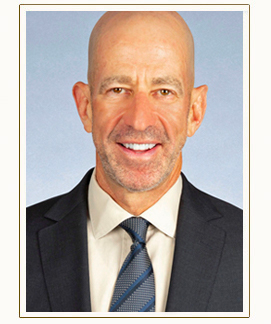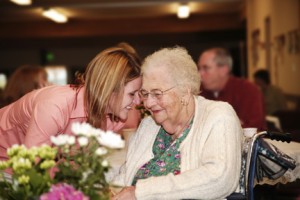Our guest blogger this week is Lou Giampa, President of Right at Home Westchester. Lou is a New York State Certified Nurse Aide (CNA) and Dementia Trainer who volunteers in hospitals and nursing homes throughout Westchester County. He also volunteers with the Alzheimer’s Association, Meals on Wheels, and the Aging in Place community. For more information, please visit www.westchesterseniorcare.com.

The family is coming for Thanksgiving and mouths are already watering just thinking about Grandma’s pumpkin pie. But did you know that during the Thanksgiving holiday, an increased number of older adults go to the emergency room? Some ER physicians see up to a 20% rise in elderly patients during the holidays.1
The Centers for Disease Control and Prevention noted that during 2012-2013, an annual average of 5.2 million ER visits among adults age 65 and older were due to injury and 15.5 million visits were due to illness.2 Over Thanksgiving, everything from fall injuries to food poisoning can leave senior loved ones putting on a hospital gown rather than their favorite pajamas and slippers.
Have a Safe Trip!
During the holidays, many families choose to travel by car, which, according to the National Safety Council, “has the highest fatality rate of any major form of transportation based on fatalities per passenger mile.”3 Alcohol impairment is a leading cause of traffic accidents around Thanksgiving when roads are congested with vehicles and in-a-hurry travelers. Following these holiday travel tips can help keep everyone safe:
- Prepare the vehicle for inclement weather and store in it a car emergency kit.
- Sleep well before departing and do not drive while drowsy.
- Avoid distractions such as using a cellphone and talking too often to passengers.
- Make sure older adults are properly buckled up and comfortable for the ride.
- For air, train or bus travel, book nonstop tickets to avoid the hassle and confusion that may result if seniors must rush from one terminal or station stop to another.
- For a senior with mobility concerns, airports and train and bus stations may offer special wheelchair assistance or an attendant to help.
Too Close for Comfort
It is tempting to pull out ample decorations for Thanksgiving and add seating throughout the house, but excess furniture, electrical cords and holiday displays can create fall hazards for all ages. It is best to keep decorations simple and pathways around the home free of clutter. Consider these holiday fall prevention tips:
- Know a senior loved one’s health conditions that could lead to falls.
- Keep clutter out of pathways.
- Be sure all flooring is tacked down, and use nonslip backing on all throw rugs and area rugs.
- Use night lights in bedrooms, bathrooms and hallways.
“In working with seniors every day, we know how quickly an elder can take a tumble and be seriously injured,” said Lou Giampa, President of Right at Home Westchester. “Holiday gatherings pose their own set of challenges with family and friends fitting into tighter spaces and rushing to get meals on the table. I highly recommend the free Right at Home Fall Prevention Guide to help keep senior loved ones and all family and guests safe this Thanksgiving.”
Food for Thought
Cooking injuries such as minor burns and cuts are a top culprit for emergency room trips on Thanksgiving, as well as candle and kitchen fires and turkey fryer incidents. While delicious, the traditional Thanksgiving meal can cause dietary challenges for older adults with health conditions. For example, many Thanksgiving dishes contain high amounts of sodium, and ingesting too much sodium can lead to a spike in blood pressure. For some seniors with heart issues, the overload of salt triggers shortness of breath, palpitations, fainting and heart failure. Excess sodium can also cause an imbalance of internal fluids that stresses the blood vessels and kidneys.4
Improper handling, cooking or storing of food are other problems that could send family and guests to the bathroom and eventually the ER on Thanksgiving. Food poisoning or severe gastritis can be particularly worrisome for seniors with already compromised immune systems. These tips will help ease concerns about food-related trips to the emergency department:
- Keep unsteady hands away from kitchen knives and hot cooking pots.
- Decrease the amounts of salt and sugar in recipes.
- Substitute healthier, lower-cholesterol fats in dishes.
- With foods that can trigger health problems, help seniors with portion control — make smaller quantities and serve smaller pieces.
- Follow food prep and food poisoning prevention guidelines.
The Best Medicine
Remind elders to pack all their medications for their holiday trip. If they are visiting only on Thanksgiving Day, ask them to bring their regular medications, plus a few dosages just in case they need to stay over a day or two. These travel tips can also help:
- Put prescription bottles in a carry-on bag and not in checked luggage, which may get lost.
- Carry a list of all medications and supplements and their dosages in case of a medical emergency.
- Bring a list of all physicians’ names, phone numbers and addresses.
Play It Safe
Family gatherings are often replete with interactive games and sports activities, and seniors want to feel included in these festivities. The traditional Thanksgiving post-meal walk or game of touch football brings much fun and laughter until someone sprains a knee or breaks a wrist. To avoid the “ouches” of Thanksgiving, try these tips for older loved ones:
- Modify activities for those with mobility or stamina limitations.
- Start any physical activity with a session of slow stretching for participants.
- Pair elders with grandkids to work on crafts, puzzles, board games and skits.
In Case of Emergency
Before Thanksgiving arrives, consider taking a first aid course or CPR training to prepare for an emergency. Learn the common symptoms of heart attack and stroke. If an older relative or guest becomes ill or is injured, consider these steps:
- For signs of a heart attack or stroke, call 911 or emergency services immediately. If the person stops breathing, perform CPR.
- If the individual fell or is injured and there are signs of serious bleeding, bruising, swelling or bone fracture, seek emergency medical care.
- If the senior appears to have a significant injury to their head, neck, back, hips or thighs, keep the senior still and do not attempt to move them. Call 911 or local emergency services.
- Calmly reassure the injured or ill individual, and keep them comfortable and warm. Do not give them food or drink.
- To treat minor injuries, follow these first aid guidelines from Mayo Clinic.
- Keep in mind that an urgent care center can handle cuts that need stitches and broken bones that need casts. Hospital ERs may expose seniors to more serious infections and subject them to extra medical tests.
Teaming Up
 Medical professionals also caution against being alarmed at the condition of older loved ones whom many relatives may not have seen in recent months. Rushing a visiting elder to a healthcare provider may be a knee-jerk response to the loved one simply going through the normal aging process.
Medical professionals also caution against being alarmed at the condition of older loved ones whom many relatives may not have seen in recent months. Rushing a visiting elder to a healthcare provider may be a knee-jerk response to the loved one simply going through the normal aging process.
“Regularly staying in contact with older loved ones and keeping abreast of their health and medical appointments will help seniors maintain better health throughout the year,” Giampa advises. “For the holidays, it is often a good idea to recruit personal assistance for older loved ones.”
Giampa notes that Right at Home’s professional, trained caregivers can accompany a loved one on the trip to see relatives and friends during Thanksgiving to provide assistance and an extra measure of safety. If the senior would happen to end up in the hospital, Right at Home’s RightTransitions® program can provide care and support to the loved one during the transition from the hospital back home. Right at Home is a pioneer in hospital-to-home care transitions for seniors, launching RightTransitions in 2010 as one of the first programs to support patients as they recover from a hospital or other care facility stay.
“Everyday health reminders, meal preparation, light housework, transportation to appointments, communication with family — Right at Home has older adults and adults with disabilities covered for Thanksgiving and any day or time of the week or weekend,” Giampa explains.
As the holiday season approaches and older relatives and friends are looking forward to joining in the Thanksgiving celebrations, now is the time to plan for their safety and comfort. Preparation steps like securing carpets and finding low-salt recipes will help keep seniors safe and healthy during this celebratory time.
1 MedicineNet, “ER Visits for Elderly Rise During Thanksgiving.” Retrieved from https://www.medicinenet.com/script/main/art.asp?articlekey=108060.
2 Centers for Disease Control and Prevention, “Emergency Department Visits for Injury and Illness Among Adults Aged 65 and Over: United States, 2012–2013.” Retrieved from https://www.cdc.gov/nchs/products/databriefs/db272.htm.
3 National Safety Council, “Enjoy a Safe Holiday Season.” Retrieved from https://www.nsc.org/home-safety/tools-resources/seasonal-safety/winter/holiday.
4 Unitek College, “Why Thanksgiving Is So Busy in Your Hospital.” Retrieved from https://www.unitekcollege.edu/blog/thanksgiving-busy-hospital/.
Learn more about elder law, estate planning and special needs planning at http://www.elderlawnewyork.com & www.littmankrooks.com. Have questions about this article? Contact us.
Was this article of interest to you? If so, please LIKE our Facebook Page by clicking here.




 For everyone else, estate plans should be created to address tax avoidance issues, property management, asset protection, wealth distribution and health care decisions in the event of cognitive decline or disability prior to death.
For everyone else, estate plans should be created to address tax avoidance issues, property management, asset protection, wealth distribution and health care decisions in the event of cognitive decline or disability prior to death. Caring for a loved one is a labor of love, very often with an emphasis on the work. Caregivers bear an incredible weight in making sure that their loved one is getting what they need while their own life is put on hold. Burnout is common.
Caring for a loved one is a labor of love, very often with an emphasis on the work. Caregivers bear an incredible weight in making sure that their loved one is getting what they need while their own life is put on hold. Burnout is common. 
 If current weather trends continue, 2018 will be the fourth hottest year on record, according to the National Oceanic and Atmospheric Administration.
If current weather trends continue, 2018 will be the fourth hottest year on record, according to the National Oceanic and Atmospheric Administration. The Department of Aging’s
The Department of Aging’s  Today there are new transportation options such as the ride-hailing services Uber and Lyft, which can be faster and less expensive than taxis. These options have been embraced quickly by much of the population, but seniors may be less familiar with them. A smartphone is essential to using the new services, and older individuals may not have smartphones or may not be as comfortable using them. Among Americans over the age of 65, only 42 percent own a smartphone, while 77 percent of the general population owns one. In addition, someone with a physical disability may require a vehicle that can accommodate an assistive device such as a walker or wheelchair, and the new services may not be set up to handle such requests.
Today there are new transportation options such as the ride-hailing services Uber and Lyft, which can be faster and less expensive than taxis. These options have been embraced quickly by much of the population, but seniors may be less familiar with them. A smartphone is essential to using the new services, and older individuals may not have smartphones or may not be as comfortable using them. Among Americans over the age of 65, only 42 percent own a smartphone, while 77 percent of the general population owns one. In addition, someone with a physical disability may require a vehicle that can accommodate an assistive device such as a walker or wheelchair, and the new services may not be set up to handle such requests.